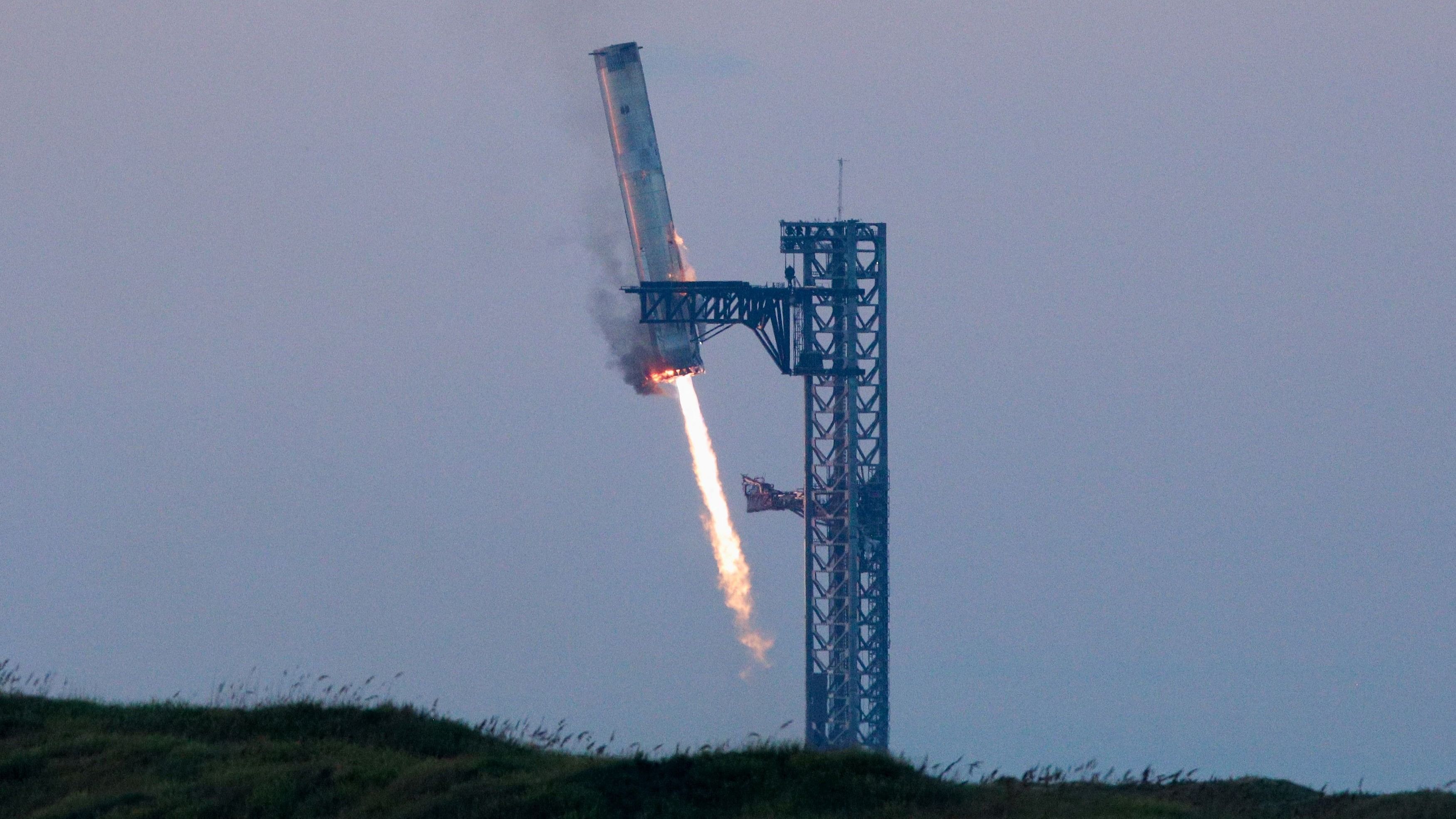
SpaceX's Starship lifts off during its fifth flight test, in Boca Chica, Texas, US.
Credit: Reuters
By Loren Grush
SpaceX stunned the world during its Starship rocket test over the weekend, catching its booster in midair after it came back from space and landing the rest of the rocket in the ocean after a plunge through Earth’s atmosphere.
The latest Starship test flight checked off two major milestones that SpaceX very much needed to achieve on the long road toward developing a rapidly reusable launch system. And now that the company has shown what the vehicle is capable of, it’s possible that Starship may soon be ready to start launching satellites, at least to low-Earth orbit.
In the meantime, the launch system — the largest and most powerful ever developed — still faces many daunting development challenges before it’s able to head to the moon for NASA, let alone anchor SpaceX Chief Executive Officer Elon Musk’s grander dream of carrying humans to Mars.
Catching the Super Heavy booster was a key hurdle the company needed to clear first, in order to progress forward.
To reach deep-space destinations like the moon and Mars, Starship will need to refuel in orbit, requiring multiple back-to-back launches of the system to fill up the tanks of one spaceship — a feat that has never been performed before in space at such a massive scale.
SpaceX still needs to demonstrate this capability, by having two Starship vehicles dock in orbit and transfer super cold propellants from one vehicle to another.
It’s unclear when such a demonstration will take place. One indication is that NASA, which plans to use Starship to land humans on the moon, anticipates it could happen as early as 2025.
During Starship’s third test flight, the company performed a demonstration experiment inside the vehicle while it was in space, transferring propellants from one small tank to another.
That occurred on a much smaller scale than what will be needed for deep-space missions. SpaceX anticipates it will need roughly “10-ish” refueling flights in order for Starship to reach the moon.
The Super Heavy catch will be critical to that plan.
After propelling Starship to space on Sunday, the Super Heavy booster returned to its launch site on Earth, where it reignited its engines to slow itself down as it came in for landing. Two arms protruding from Starship’s launch tower then “caught” the booster, as cheers and applause erupted at mission control.
Once these catches are perfected, SpaceX plans to quickly fuel up Super Heavy boosters on Earth and place Starship “tankers” on top of them, launching them again relatively quickly after each catch.
Sunday’s flight was a showcase of SpaceX’s pioneering fly-fail-fix approach to space travel, an iterative strategy that has propelled its smaller Falcon 9 to become the world’s most-flown rocket.
NASA Administrator Bill Nelson sounded eager for SpaceX to keep up the momentum.
“Continued testing will prepare us for the bold missions that lie ahead — including to the South Pole region of the Moon and then on to Mars,” Nelson said in a social media post on Sunday.
With Starship, SpaceX’s eventual aim is to fully recover the vehicle’s two main parts: the Starship spacecraft itself — which will carry satellites and eventually passengers — and the Super Heavy booster.
By recovering both of these pieces after flight, SpaceX hopes to rapidly reuse and relaunch the hardware following takeoff, allowing for multiple flights of Starship in a single day. The company also expects full reusability to drastically lower the cost of launching Starship.
Read More: SpaceX’s Colossal Starship Sets Pace in Race to Build Larger Rockets
Now, SpaceX can start to develop techniques to turn around the Super Heavy booster and ready it for another flight — something the company will need to perfect if it’s going to launch multiple refueling missions in a row.
It’s also possible that SpaceX may choose to start launching satellites from Starship relatively soon, as the company has started to showcase the vehicle’s ability to reach near orbital speeds during previous test flights. SpaceX hopes to use Starship to launch much larger and more powerful satellites for its Starlink internet system.
One wild card in SpaceX’s plans is the US Federal Aviation Administration. Sunday’s mission unfolded against the backdrop of Musk openly criticizing the FAA over the speed with which the FAA approves commercial space launch licenses.
SpaceX has been raising the concern in recent years as it tries to launch Starship more frequently. In September, the company said the FAA notified it that the license for this mission wouldn’t be granted until late November — a timeline that SpaceX said was slow and inefficient.
“Missions change. Technologies on the vehicles change, which require a modification to the license,” Kelvin Coleman, the head of the FAA’s Commercial Space Transportation office, told a House hearing last month.
“It is the company that is pushing mission-by-mission approvals,” he added. “That’s what the pace is about.”